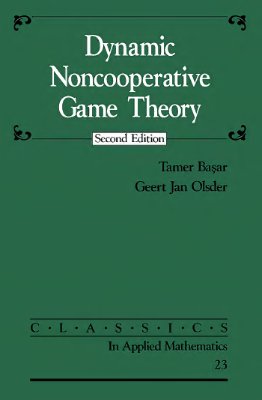Society for Industrial and Applied Mathematics, 1999, -536 pp.
This is the revised second edition of our 1982 book with the same title, which presents a rather comprehensive treatment of static and dynamic noncooperative game theory, with emphasis placed (as in the first and second editions) on the interplay between dynamic information pattes and the structural properties of several different types of equilibria. Whereas the second edition (1995) was a major revision with respect to the original edition, this Classics edition only contains some moderate changes with respect to the second one. There has been a number of reasons for the preparation of this edition:
The second edition was sold out surprisingly fast.
After some fifty years from its creation, the field of game theory is still very alive and active, as also reinforced by the selection of three game theorists (John Harsanyi, John Nash and Reinhard Selten) to share the 1994 Nobel prize in economics. Quite a few books on game theory have been published during the last ten years or so (though most of them essentially deal with static games only and are at the undergraduate level).
The recent interest in such fields as biological games, mathematical finance and robust control gives a new impetus to noncooperative game theory.
The topic of dynamic games has found its way into the curricula of many universities, sometimes as a natural supplement to a graduate level course on optimal control theory, which is actively taught in many engineering, applied mathematics and economics graduate programs.
At the level of coverage of this book, dynamic game theory is well established by now and has reached a level of maturity, which makes the book a timely addition to SIAM's prestigious Classics in Applied Mathematics series.
For a brief description of and the level of the contents of the book, the reader is referred to the Preface of the second edition, which follows. It suffices to mention here the major changes made in this Classics edition with respect to the second edition. They are:
Inclusion of the "Braess paradox" in Chapter 4.
Inclusion of new material on the relationship between the existence of solutions to Riccati equations on the one hand and the existence of Nash equilibrium solutions to linear-quadratic differential games on the other, in Chapter
6. In the same chapter some new results have been included also on infinite-horizon differential games.
We hope that this revised edition may find its way as its predecessors did.
Introduction and Motivation
Part I
Noncooperative Finite Games: Two-Person Zero-Sum
Noncooperative Finite Games: TV-Person Nonzero-Sum
Static Noncooperative Infinite Games
Part II
General Formulation of Infinite Dynamic Games
Nash and Saddle-Point Equilibria of Infinite Dynamic Games
Stackelberg Equilibria of Infinite Dynamic Games
Pursuit-Evasion Games
Mathematical Review
Some Notions of Probability Theory
Appendix C Fixed Point Theorems
This is the revised second edition of our 1982 book with the same title, which presents a rather comprehensive treatment of static and dynamic noncooperative game theory, with emphasis placed (as in the first and second editions) on the interplay between dynamic information pattes and the structural properties of several different types of equilibria. Whereas the second edition (1995) was a major revision with respect to the original edition, this Classics edition only contains some moderate changes with respect to the second one. There has been a number of reasons for the preparation of this edition:
The second edition was sold out surprisingly fast.
After some fifty years from its creation, the field of game theory is still very alive and active, as also reinforced by the selection of three game theorists (John Harsanyi, John Nash and Reinhard Selten) to share the 1994 Nobel prize in economics. Quite a few books on game theory have been published during the last ten years or so (though most of them essentially deal with static games only and are at the undergraduate level).
The recent interest in such fields as biological games, mathematical finance and robust control gives a new impetus to noncooperative game theory.
The topic of dynamic games has found its way into the curricula of many universities, sometimes as a natural supplement to a graduate level course on optimal control theory, which is actively taught in many engineering, applied mathematics and economics graduate programs.
At the level of coverage of this book, dynamic game theory is well established by now and has reached a level of maturity, which makes the book a timely addition to SIAM's prestigious Classics in Applied Mathematics series.
For a brief description of and the level of the contents of the book, the reader is referred to the Preface of the second edition, which follows. It suffices to mention here the major changes made in this Classics edition with respect to the second edition. They are:
Inclusion of the "Braess paradox" in Chapter 4.
Inclusion of new material on the relationship between the existence of solutions to Riccati equations on the one hand and the existence of Nash equilibrium solutions to linear-quadratic differential games on the other, in Chapter
6. In the same chapter some new results have been included also on infinite-horizon differential games.
We hope that this revised edition may find its way as its predecessors did.
Introduction and Motivation
Part I
Noncooperative Finite Games: Two-Person Zero-Sum
Noncooperative Finite Games: TV-Person Nonzero-Sum
Static Noncooperative Infinite Games
Part II
General Formulation of Infinite Dynamic Games
Nash and Saddle-Point Equilibria of Infinite Dynamic Games
Stackelberg Equilibria of Infinite Dynamic Games
Pursuit-Evasion Games
Mathematical Review
Some Notions of Probability Theory
Appendix C Fixed Point Theorems

